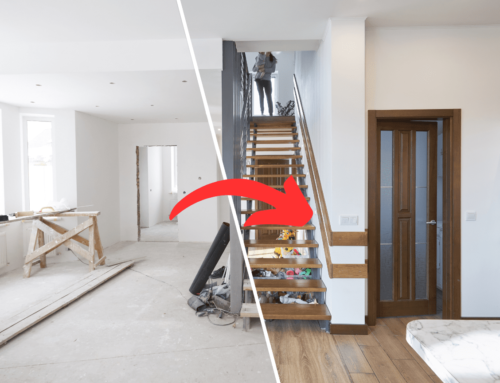For our audio-visual learners, here’s a video explaining the 5 Stages to House Flipping.
Table of Contents
5 Stages to House Flipping
Are you starting a career in making properties profitable and affordable? Whether you’re a DIY house flipper or a real estate investor self-managing a project, this guide is for you! Understanding the five stages of house flipping and renovation will help you optimize operations and save money.
House Flipping Stage One | Structural
Revamping a home involves careful consideration of the structure. For instance, if you need to open up a doorway, you should hire the same crew for the entire project. You’ll need structural experts to handle tasks like opening windows and moving walls.
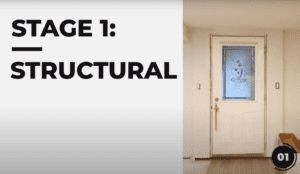
How to Save Money
To avoid overpaying, here are some ballpark figures:
- Cutting a hole in a cinder block wall might cost around $600. This price doesn’t include necessary reinforcement.
- Adding a lintel and ensuring the structure’s stability will bring the total cost to between $1,200 and $1,800. This estimate covers only the hole-cutting, not additional expenses like the door, external excavation, or permits.
Sequencing the Work
To save money, consolidate all structural work. The same crew that cuts the door can also open up your windows. It’s best to complete this before framing so the framing team can work around the new openings later. After cutting the holes, the crew will board them up with plywood and prepare them for window installation.
If you need to move any walls, it’s crucial to distinguish between partition walls and load-bearing walls. Checking the beams and joists for load-bearing walls will give you a deeper understanding of the structural implications. If your renovation involves significant structural changes, get the same experts to handle everything.
House Flipping Stage Two | Framing and Lumber
We separate this stage because hiring the same expensive structural crew for framing isn’t cost-effective. As a real estate investor, correctly sequencing the work helps you save money on renovations and house flipping projects.
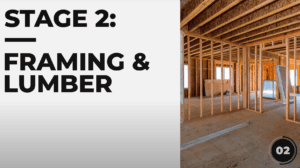
Hiring the Right Crew
For this stage, consider the cost-saving benefits of hiring specialized framing contractors. These professionals are less costly than structural crews and can handle the job efficiently, ensuring you stick to your budget. They should be able to handle everything from framing walls and bulkheads to accommodating HVAC systems and other mechanical requirements.
Costs Breakdown
Material costs are significant when planning how to construct a house. For a 1,000 square foot apartment, expect to spend around $700 on lumber just for the walls. This figure doesn’t include costs for ceilings, bulkheads, or any additional framing needs. Realistically, the budget is approximately $11,000 for the entire lumber cost.
House Flipping Stage Three | Mechanicals
This stage involves critical systems like plumbing, electrical, and HVAC. Here’s how to manage this stage effectively.
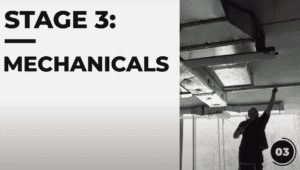
Hiring Specialized Trades
One effective strategy to cut costs is to hire the right people. For example, hiring an electrician to rewire the entire house can get pricey. However, apprentices can do much of the rewiring work under the supervision of a licensed electrician. Similarly, apprentices can fish PEX pipes through the walls with plumbing, while the licensed plumber handles the final finishes.
Costs Breakdown
Modern plumbing often uses PEX piping, which is easier to install than old copper pipes that require soldering. An apprentice can fish the PEX pipes through the walls while the licensed plumber handles the final finishes, costing about $600 on plumbing materials, including ABS pipes.
Scope
Monitor material costs and the project scope closely. You can save significantly by keeping the plumbing layout unchanged, avoiding moving kitchens or bathrooms, and using modern, easy-to-install quality materials.
House Flipping Stage Four | Drywall, Plaster, and Paint
This stage will transform your space from a construction site into a home. Installing drywall is a significant step in creating the foundation for your interior walls. Once the drywall is up, plastering ensures the walls are smooth and have a professional finish.
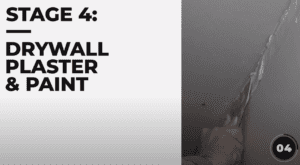
Costs Breakdown
For a 1,000 square foot basement, we spent about $1,500 on drywall materials for around 100 sheets. Additionally, expect to pay around $600 on plastering and mud materials for the entire place. Painting, the final touch to your walls and ceilings, can be cost-effective if done correctly. We opted to spray paint the whole place, which allowed for quick coverage, costing around $500 in paint materials, including primer and ceiling paint, bringing this stage’s total cost from $2,500 to $3,000.
House Flipping Stage Five | Finishes
Finishing items include flooring, kitchens, cabinets, countertops, appliances, light fixtures, and similar elements. After completing the main construction, finishing items cover everything related to personal preference and style choices.
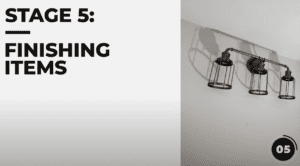
Cost-Effective Strategy: Bulk Purchasing
We recommend 5.5mm vinyl plank with an underpadding for basement floors. This material is cost-effective, ranging from $2 to $3 per square foot. Buying wholesale can reduce costs to about $1.50 to $1.60 per square foot.
Choosing the Right Materials
Vinyl planks provide a balance of rigidity and flexibility, allowing them to conform to slightly uneven floors while preventing the annoying clapping sound that occurs when there’s a gap. They are also easy to install; the planks click together smoothly and securely, giving them a tight fit without much hassle. When selecting finishing materials, it is essential to balance quality and cost. Cheap materials can lead to installation problems and durability issues, while overly expensive choices might not offer a good return on investment.
Conclusion
Successful house flipping and renovation projects require careful planning and strategic execution across all stages. Each step, from structural modifications to finishing touches, presents opportunities to minimize costs and maximize returns. Real estate investors can achieve polished results by consolidating tasks, hiring specialized professionals, and bulk purchasing cost-effective materials while staying within budget. Following these stages and tips can help you achieve profitability and success in the real estate market.
Start Your Investing Journey
Are you interested in real estate investing? Are you struggling with the high barriers to entry to the Canadian real estate market? Join us now and see how we can help you acquire your first US real estate deal in the next 45 days!
Fill out the application form below and take the first step towards expanding your investment portfolio across the border.

